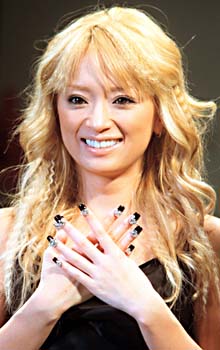I was scrolling through Apartment Therapy's blogs, admiring the lovely photos when my eyes caught the words "Papasan Chair." I've always adored the idea of a giant pillowy chair, and I can't help but plop down in one for a few seconds every time I visit Cost Plus World Market, but I don't actually have one of my own. The only thing I'm not fond of with the papasan chair is the bamboo structure. It is just very unappealing to me as a complement to the soft cushion, because it makes me feel like the chair belongs outdoors in a patio and not in my room for lounging.
On the blog, someone had posted a request from readers for ideas of alternatives to a papasan chair. One of the comments suggested looking at Ligne Roset's "Pumpkin" chair, and through curiosity I decided to look it up.
 Photo courtesy of Ligne Roset.
Photo courtesy of Ligne Roset.
The "Pumpkin" chair reminded me of thumbprint cookies, because it was essentially a large cushion with a rounded dent in the center. Unlike the papasan chair, it was entirely covered in fabric, making it more obvious as indoor furniture, and it also gave it a more luxurious look.
 Photo courtesy of Ligne Roset.
Photo courtesy of Ligne Roset.
Ligne Roset's entire collection of products, which range from furniture for the dining room, living room, office and bedroom, are a harmonious display of sleek meets comfort. The strong lines in this collection paired with simplicity give them a modern feel, and rather than looking stiff and uninviting, they appear comfortable and warm because of the choices in materials and shape.
 Photo courtesy of Ligne Roset.
Photo courtesy of Ligne Roset.
For example, the armchair "Torn" has a structure that looks like it could be folded from paper. These "folds" create lines which are a prominent part of its design. The arms on the chair are two pieces folded forward and these creases are the most noticeable, and also the most unique and attractive part of the design. It highlights the contrast of the soft cushion and the hard base. Looking at the chair as a whole, there are certainly elements that make it look inviting rather than intimidating. With a slight tilt backward and its forward-facing arms, it looks as if it's ready for a hug.
 Photo courtesy of Ligne Roset.
Photo courtesy of Ligne Roset.
Having a similar effect as the arm in the "Torn" armchair is the "Moel" chair. The middle of the back of the chair is noticeably higher, then slopes down on both sides, wrapping around as arms which curve outward. It has a distinctive silhouette like a flower in bloom, and the open arms signify invitation. Similar to "Torn", it also has strong lines as part of the design, but paired with elements that create a warmer feeling.Both chairs, are examples from the collection I enjoyed most for how well they demonstrate the harmony of rigid structure with comfort. They demonstrate how two seemingly opposite characteristics can be combined beautifully, inspiring combinations that may seem unlikely to work.
The search for a papasan alternative, and Ligne Roset's creation of the "Pumpkin chair", is a great example of observing what has already been done, and improving or updating it to fit the needs and desires of modern society. It inspires looking at designs from history or globally to think about its appeal and bringing that idea into a modern design.
 Model Candice Swanepoel on the Victoria's Secret Fashion Show. Photo courtesy of Yahoo.
Model Candice Swanepoel on the Victoria's Secret Fashion Show. Photo courtesy of Yahoo. Model Candice Swanepoel on the Victoria's Secret Fashion Show. Photo courtesy of Yahoo.
Model Candice Swanepoel on the Victoria's Secret Fashion Show. Photo courtesy of Yahoo.















































